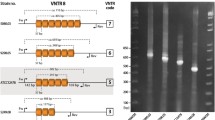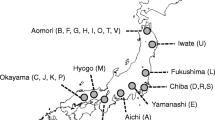Summary
We have analyzed nine different species of the filamentous fungus Trichoderma and three strains of T. reesei for the presence of hypervariable loci in their genomes by hybridization with simple repeat oligonucleotides [(CT)8, (GTG)5, and (GACA)4]. On the basis of the DNA-fingerprints obtained, the Trichoderma aggregate is re-classified into five groups: I (T. reesei, T. todica), II (T. polysporum, T. longibrachiatum, T. koningii, and T. pseudokoningii), III (T. virgatum), IV (T. saturnisporum) and V (T. harzianum). These results contradict the claim that T. reesei is a subspecies of T. longibrachiatum. Furthermore, hybridization with (CA)8 allowed a subdivision of group II, wherein T. pseudokoningii formed a subgroup, IIb, which is highly homologous with, but distinct from subgroup IIa. The results show that RFLP analysis may be used to re-classify the Trichoderma aggregate.
Similar content being viewed by others
References
Bisset J (1984) Can J Bot 62:924–931
Braithwaite KS, Manners JM (1989) Curr Genet 16:473–475
Brian PW (1941) Nature 155:667–668
Dennis C, Webster J (1971) Trans Brit Mycol Soc 57:25–29
Dreyfuss M, Härri E, Hoffman H, Kobel H, Pache W, Tscherter H (1976) Eur J Appl Microbiol Biotechnol 3:125–133
El Gogary S, Leite A, Crivellaro O El Dorry H, Eveleigh DE (1990) In: Kubicek CP, Eveleigh DE, Esterbauer H, Steiner W, Kubicek-Pranz EM (eds) Trichoderma cellulases: biochemistry, physiology, genetics and applications. Royal Chem Soc Press, Cambridge, England, pp 200–211
Förster H, Oudemans P, Coffey MD (1990) Exp Mycol 14:18–31
Gruber F, Visser J, Kubicek CP, De Graaff L (1990) Curr Genet 18:71–76
Kubicek CP, Eveleigh DE, Esterbauer H, Steiner W, Kubicek-Pranz EM (1990) Trichoderma cellulases: biochemistry, physiology, genetics and applications. Royal Chem Soc Press, Cambridge, England
Kusters-van Someren MA, Samson RA, Visser J (1991) Curr Genet 19:21–26
Manicom BQ, Bar-Josef M, Rosner A, Vigodsky-Haas H, Kotze JM (1987) Phytopathology 77:669–672
Martin FN, Kistler HC (1990) Exp Mycol 14:32–46
McDonald BA, Martinez JP (1990) Curr Genet 17:133–138
Meyer W, Koch A, Niemann C, Beyermann B, Epplen JT, Börner T (1991) Curr Genet 19:239–242
Michelmore RW, Hulbert SH (1987) Annu Rev Phytopathol 25:383–403
Midorikawa Y (1979) Agric Biol Chem 43:1749–1752
Morawetz R, Gruber F, Messner R, Kubicek CP (1991) Curr Genet 21:31–36
Papavizas GC (1985) Annu Rev Phytopathol 23:23–54
Rifai MA (1969) Mycol Papers 116:1–56
Sambrook J, Fritsch EF, Maniatis T (1990) Molecular cloning: a laboratory manual. Cold Spring Harbor Laboratory. Cold Spring Harbor, New York
Schäfer R, Zischler H, Birsner U, Becker A, Epplen JT (1988) Electrophoresis 9:369–374
Simmons EG (1977) Abstracts 2nd Inter Mycol Congress. Tampa, Florida, p 618
Author information
Authors and Affiliations
Additional information
Communicated by R. J. Schweyen
Rights and permissions
About this article
Cite this article
Meyer, W., Morawetz, R., Börner, T. et al. The use of DNA-fingerprint analysis in the classification of some species of the Trichoderma aggregate. Curr Genet 21, 27–30 (1992). https://doi.org/10.1007/BF00318650
Received:
Issue Date:
DOI: https://doi.org/10.1007/BF00318650




